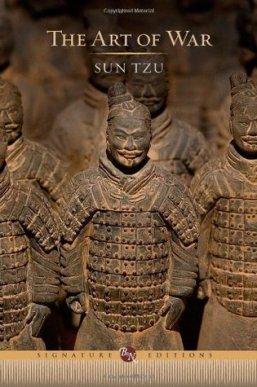
And here I thought it was The Art of Terracotta.
So, that whole “I’m gonna read all these books in 2015,” thing I was going on about? Thems was jokes! I was foolin’ y’all! The reading challenge is for two years! Always meant for it to be that way. Totally…. But yeah, let’s get Chapter 14 started. I’m not much of a nonfiction kind of guy, so I legitimately had a rough time figuring out what to read for this one. I finally settled on one of the classics that is far shorter than I thought it was. And yet it still took me two weeks to read Sun Tzu’s The Art of War.
The Art of War is one of those that I think everyone knows about–up there with Moby-Dick, The Odyssey, The Count of Monte Cristo, and other such classics. You may not have read them, but you at least kinda know what they’re about. Books like this have permeated the culture. I think, at least. Anyway, I’ve always known there was this Sun Tzu guy telling everybody how to conduct war, and that’s…exactly what this book is.
Leonard Giles’s translation seems to be the translation for the English-speaking world. Not only did he finally translate the work with the respect it deserves, but he also chose the best commentary from past pundits to include in the text. His own commentary was often quite insightful as well. The edition I purchased has both versions–with and without commentary. I read the one without to see how Sun Tzu’s rules affected me. Also, it was shorter, and my laziness knows no bounds. I did go to the commentary version for each chapter to see what else I could glean, though. That’s probably the route I would suggest for anyone interested in reading The Art of War.
Another thing I quite enjoyed about this edition was the introduction. I’ve gotten to where I check out the introductions for the books I read (I used to loathe doing so), and it’s another thing I suggest everyone does. Turns out Sun Tzu is kinda similar to King Arthur. We know the two of them existed, but an awful lot gets attributed to them that they couldn’t have possibly done. In fact, Sun Tzu may not have even written The Art of War! I’m sorry, but I just find that really cool.
At this point, you–dear reader–might have noticed I haven’t talked to much about the content aside from Giles’s helpful analysis. Well, that’s because I’m not exactly sure what to say. This is an advice book for war. Sure, countless people have adapted it for business and sports, and I find that truly fascinating. That goes to show the enduring power of this text. I don’t find it to resonate too much with me, though. Except for the, “If you know neither the enemy nor yourself, you will succumb in every battle,” line. But, that’s probably the most famous bit from the book.
The Art of War isn’t for everyone, but it is an essential for those who seek to be leaders. Sun Tzu’s (or whoever’s) words are as true now as they were way back then (well, maybe not all of his words), and I’m glad I finally read his book.
The now two-year reading challenge will continue with a popular author’s first book. What will it be? Stay tuned to find out.